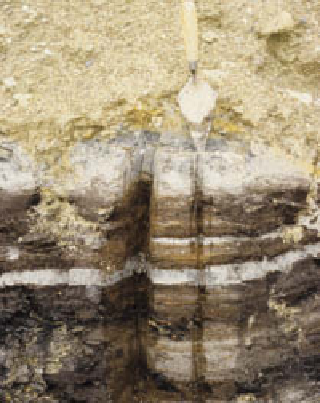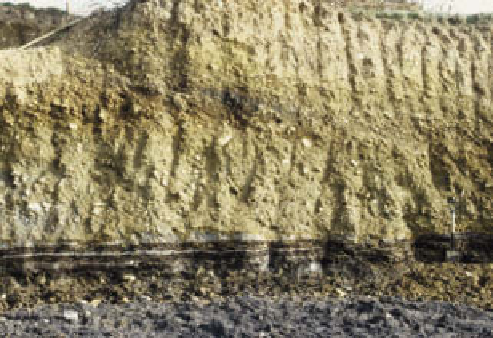Geoscience Reference
In-Depth Information
(a)
(b)
(c)
(d)
Plate 23.11
(a) General character of Hanson's quarry at Pen-y-bryn, showing active quarry benches in dark grey Ordovician
shale beneath Quaternary glacigenic overburden. (b) One of the organic channel lenses draped by local grey Welsh glacial till,
overlain by glaciofluvial gravels and then reddish-brown Irish Sea basin till. (c) A 'monolith' of peat layers marked and cut ready to
excavate as a single block, preserving its stratigraphic integrity for dating and pollen analytical purposes. (d) Four wood
macrofossil samples recovered from the organic lenses and basal Welsh till, and identified from their cell anatomy as Abies(fir),
Juniperus(juniper) and Picea(spruce) or Larix(larch).
Photos: Ken Addison
cooler, drier assemblage at Chelford just 130 km farther
east but may confirm other evidence that Atlantic coast,
maritime qcontinental climate gradients were steeper
during cold stages than today, due to different positions
of the Atlantic Polar Front and Gulf Stream.
The age and source of glacigenic sediments now require
resolution. Local Welsh and more distantly sourced Irish
Sea basin tills are differentiated by matrix colour, derived
from respective sources in the Lower Palaeozoic volcan-
oclastic and slate rocks of Snowdonia (grey) and Mesozoic
sandstones of Liverpool Bay (red-brown). Irish Sea basin
tills also contain a more diverse erratic assemblage,
including
indicator
erratics of Scottish granites and Lake
District volcanics absent from Welsh tills. All three tills and
glaciofluvial sediments are differentiated on four further
counts.
Particle size analyses
of sand-silt-clay fractions
shows that farther-travelled Irish Sea basin tills are finer,
attributed to greater in-transit attrition.
Palaeocurrent
analyses
reconstruct Welsh ice flow to the north-west
from Snowdonia and towards the south-west for Irish Sea
ice, deflected by the mountains.
Mineral magnetic analyses
show higher concentrations of both ferrimagnetic (e.g.
magnetite) and antiferromagnetic (e.g. haematite) in the
Irish Sea till, compared with low magnetic minerals of all
types in Welsh till, matching their source rocks. Their
respective geochemical signatures also differ
,
revealed in













































